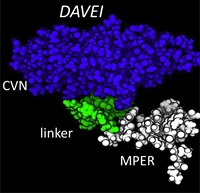Disarming HIV With a "Pop"
 PHILADELPHIA, September 19, 2013 - Pinning down
an effective way to combat the spread of the human immunodeficiency virus, the viral precursor to AIDS, has long been a challenge
for scientists and physicians, because the virus is an elusive one that mutates frequently and, as a result, quickly becomes
immune to medication. A team of Drexel University researchers is trying to get one step ahead of the virus with a
microbicide they've created that can trick HIV into "popping" itself into oblivion. PHILADELPHIA, September 19, 2013 - Pinning down
an effective way to combat the spread of the human immunodeficiency virus, the viral precursor to AIDS, has long been a challenge
for scientists and physicians, because the virus is an elusive one that mutates frequently and, as a result, quickly becomes
immune to medication. A team of Drexel University researchers is trying to get one step ahead of the virus with a
microbicide they've created that can trick HIV into "popping" itself into oblivion.
Its name is DAVEI - which stands for "Dual Action Virolytic Entry Inhibitor"- and it can pull a fast one on HIV. DAVEI
was invented and tested by scientists from Drexel's College of Engineering; School of Biomedical Engineering, Science and Health
Systems; and College of Medicine, and is the latest in a new generation of HIV treatments that function by specifically
destroying the virus without harming healthy cells.
"While several molecules that destroy HIV have recently been announced, DAVEI is unique among them by virtue of its design,
specificity and high potency," said Dr. Cameron Abrams, a professor in Drexel's College of Engineering and
a primary investigator of the project.
A team co-led by Abrams and Dr. Irwin Chaiken in the Department of Biochemistry and Molecular Biology in
Drexel's College of Medicine, and including Dr. Mark Contarino and doctoral students Arangassery
Rosemary Bastian and R. V. Kalyana Sundaram , developed the chimeric recombinantly engineered
protein - that is, a molecule assembled from pieces of other molecules and engineered for a specific purpose, in this
case to fight HIV. Their research will be published in the October edition of
the American Society for Microbiology's Antimicrobial Agents and Chemotherapy .
The idea behind DAVEI was to design a molecule that hijacks the virus's fusion machinery, the tools it uses to attach to
and attack a healthy cell, and tricks the virus into destroying itself. HIV invades a healthy cell by first attaching via
protein "spikes" that then collapse to pull viral and cell membranes together, fusing them and allowing the genetic
contents of the virus to enter the healthy cell. The cell is rewired by the viral genetic material into producing
more viruses instead of performing its normal function, which, in the case of cells infected by HIV, involves
normal immunity. AIDS is the result.
"We hypothesized that an important role of the fusion machinery is to open the viral membrane when triggered, and it follows that
a trigger didn't necessarily have to be a doomed cell," Abrams said. "So we envisioned particular ways the components of the
viral fusion machinery work and designed a molecule that would trigger it prematurely," Abrams said.
The team designed DAVEI from two main ingredients. One piece, called the Membrane Proximal External Region (MPER), is itself a small
piece of the fusion machinery and interacts strongly with viral membranes. The other piece, called cyanovirin, binds to the sugar
coating of the protein spike. Working together, the MPER and cyanovirin in DAVEI "tweak" the fusion machinery in a way
that mimics the forces it feels when attached to a cell.
"For lack of a better term, DAVEI 'tricks' the virus into 'thinking' it is about to infect a healthy cell, when, in fact,
there is nothing there for it to infect," Abrams said. "Instead, it releases its genetic payload harmlessly and dies."
Chaiken's lab has extensively studied the molecular mechanisms of HIV-1 envelope protein interactions and structure-based
design of agents that fight HIV. The researchers produced DAVEI using recombinant protein engineering and used HIV-1
pseudoviruses to demonstrate that it can physically rupture and irreversibly inactivate the virus particles.
"DAVEI and other new-generation virolytic inactivators open up an important opportunity to develop a topical microbicide to
block the transmission of HIV, and at the same time provide lead ideas to discover treatment strategies for people who are
already infected," Chaiken said. "Our hope is that determining the structural driving forces of both inhibitors
and viral entry machinery that enable spike inactivation will help to advance molecular designs with increased power,
specificity and clinical potential for both prevention and treatment."
###
Contact:
Britt Faulstick
News Officer, University Communications
britt.faulstick@drexel.edu
Phone: 215-895-2617
Mobile: 215-796-5161
Ed Federico
Media Relations Manager, Drexel University College of Medicine
edward.federico@drexelmed.edu
Phone: 215-255-7331
For more HIV and AIDS News visit...
Positively Positive - Living with HIV/AIDS:
HIV/AIDS News |